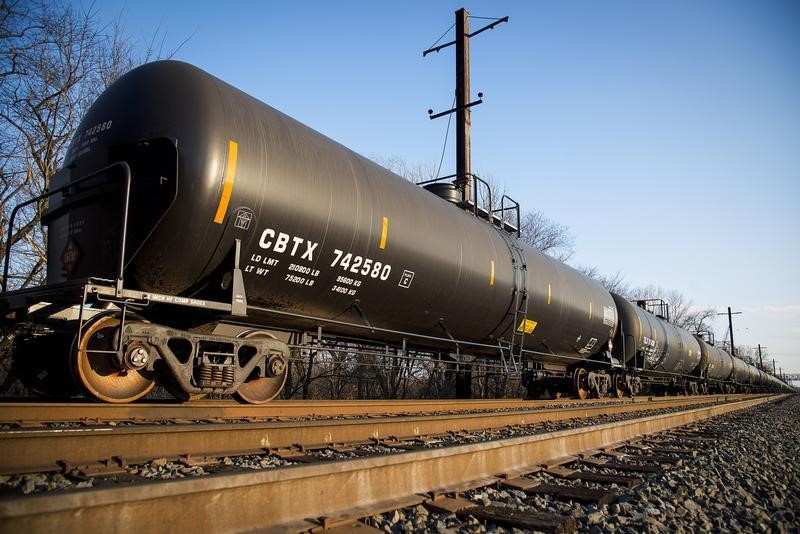(Drops paragraph 7 of March 27 story to remove incorrect reference to government subsidies)
By Anirban Paul and Ahmed Farhatha
March 27 (Reuters) - Canadian railway operators see a lucrative opportunity to transport more crude oil to the United States as a rise in output force producers to find new routes to its southern neighbor.
However, their need for long-term contracts and the pressure to move a surplus of grains in the country is making it hard to cash-in on the prospect.
Canada moves about 95 percent of its oil by pipelines, which are currently full. A 20 percent rise in crude production in the past five years has increased pressure to find new ways to haul the commodity, with rail being the second cheapest alternative.
Analysts expect railway operator Canadian Pacific Railway CP.TO to see a more than 60 percent rise in the volumes of crude it ships this year, but the company and its rival Canadian National Railway (CN) CNR.TO are being cautious about going all-in.
With oil prices volatile and three pipeline expansions due to come on line at the end of decade, railways worry that any investment will be at risk in two or three years and could undercut their money-making base - moving grains.
"Rails don't view crude by rail as a sustainable business, but rather, one that is driven by short-term dislocations in crude prices," said Stifel analyst Michael Baudendistel.
In 2017, 23 percent of Canadian Pacific's revenue came from grains and only 3 percent from crude, according to data by Desjardins analyst Benoit Poirier. Canadian National saw 13 percent of its revenue from grains and 2 percent from crude, in the same period.
"We understand crude is only going to be here for a certain period of time," Canadian Pacific's Chief Executive Officer Keith Creel said in a fourth-quarter results call with analysts.
"We're looking for strategic partners with long-term objectives that align with ours. We're not going to allow ourselves to be commoditized."
Still, RBC analyst Walter Spracklin says Canadian National and Canadian Pacific could see, respectively, 5 and 11 percent upside in earnings this year helped by crude shipments, if oil sands production increases by 315,000 barrels per day. Other analysts expect even more of an impact to their bottom lines.
LONG-TERM PACTS NEEDED
Rail companies are reluctant when it comes to monthly, spot deliveries and the inherent volatility of the oil markets make it hard for them to get long-term commitments https://www.reuters.com/article/us-canada-crude-railway/canada-oil-producers-exhaust-options-as-pipelines-railroads-fill-idUSKBN1EC0GW from vendors.
Cenovus Energy CVE.TO , which expects to double its daily output to 350,000 barrels during the first quarter over last year, recently complained that transport bottlenecks had made it impossible to haul oil. The company said it was having "ongoing discussions" with rail operators to resolve the shortage of rail hauling capacity. operators cannot think of one to three-year investments when they invest in tank cars that are intended for a more than 30-year life span, said Genscape analyst Mike Walls.
Producers on the other hand are wary of the long-term commitments railways are asking for, which is costlier than pipelines.
To make a rough estimate, pipelines cost about $6-$12 per barrel to move crude from Hardisty in Alberta to the Gulf Coast, while it costs about $16-$18 per barrel when using rail.
Major pipelines are expected to complete capacity expansions by 2020. Enbridge Inc ENB.TO is expected to double the capacity of an existing line to 760,000 barrels per day, while Kinder Morgan (NYSE:KMI) Canada KML.TO plans to triple its capacity with the expansion of its Trans Mountain pipeline beginning 2020.
TransCanada Corp TRP.TO said last month it expects to start construction on its $8 billion Keystone XL expansion in 2019 and it will take about two years to complete https://www.reuters.com/article/us-transcanada-results/transcanada-to-proceed-with-canada-gas-line-expansion-profit-beats-idUSKCN1FZ1JL.
The International Energy Agency says crude shipments by rail will ease to 170,000 barrels per day (bbl/d) in 2020 from about 250,000 bbl/d in 2018, when Enbridge's Mainline pipeline is expected to complete a capacity expansion.
But until that happens, railways could move more than 400,000 barrels of oil per day and movements could even be higher if pipelines face further delays, said IHS Markit analyst Kevin Birn.
"They want longer term commitments from oil producers and we think those commitments will be made... (but) the long term role depends on pipes," he said.
<^^^^^^^^^^^^^^^^^^^^^^^^^^^^^^^^^^^^^^^^^^^^^^^^^^^^^^^^^^^ Canadian Oil Output
https://reut.rs/2I55QuB
^^^^^^^^^^^^^^^^^^^^^^^^^^^^^^^^^^^^^^^^^^^^^^^^^^^^^^^^^^^> (Editing by Bernard Orr)
